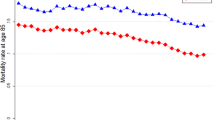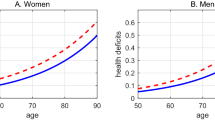Abstract
Life table methods are developed for populations whose members differ in their endowment for longevity. Unlike standard methods, which ignore such heterogeneity, these methods use different calculations to construct cohort, period, and individual life tables. The results imply that standard methods overestimate current life expectancy and potential gains in life expectancy from health and safety interventions, while underestimating rates of individual aging, past progress in reducing mortality, and mortality differentials between pairs of populations. Calculations based on Swedish mortality data suggest that these errors may be important, especially in old age.
Similar content being viewed by others
References
Keyfitz, N. 1978. Improving Life Expectancy: An Uphill Road Ahead. American Journal of Public Health 10:954–956.
Manton, K. G., and E. Stallard. 1979. Maximum Likelihood Estimation of a Stochastic Compartment Model of Cancer Latency: Lung Cancer Mortality Among White Females in the U.S. In press: Computers and Bio-Medical Research.
Manton, K. G., E. Stallard, and J. W. Vaupel. 1979. Explaining the Black-White Mortality Crossover: A Model of Selection on Heterogeneous Populations. (Unpublished manuscript).
Nam, C. B., and K. A. Okay. 1977. Factors Contributing to the Mortality Crossover Pattern. XVII General Conference of the International Union for the Scientific Study of Population, Mexico City.
Shepard, D. S., and R. J. Zeckhauser. 1975. The Assessment of Programs to Prolong Life, Recognizing Their Interaction with Risk Factors. Discussion paper 32-D, Kennedy School of Government, Harvard University, Cambridge, Mass.
— 1977. Heterogeneity Among Patients As a Risk Factor in Surgical Decision-Making. In J. P. Bunker et al. (ed.), Costs, Risks, and Benefits of Surgery. New York: Oxford University Press.
Strehler, B. L. 1977. Time, Cells, and Aging. New York: Academic Press.
Thornton, R. G., and C. B. Nam. 1972. The Lower Mortality Rates of Non-Whites at the Older Ages: An Enigma in Demographic Analysis. Research Reports in Social Science 11:1–8.
Tolley, H. D., D. Burdick, K. G. Manton, and E. Stallard. 1978. A Compartment Model Approach to the Estimation of Tumor Incidence and Growth: Investigation of a Model of Cancer Latency. Biometrics 34: 377–389.
Vaupel, J. W. 1976. Early Death: An American Tragedy. Law and Contemporary Problems 4:73–121.
—, K. G. Manton, and E. Stallard. 1979. What Demographic Difference Does It Make That the Frail Die First?: A Model of Mortality and Some Suggestive Results Based on Swedish Mortality Since 1778. Working Paper 179, Institute of Policy Sciences and Public Affairs, Duke University, Durham, N.C.
Woodbury, M. A., and Manton, K. G. 1977. A Random Walk Model of Human Mortality and Aging. Theoretical Population Biology 11:37–48.
Author information
Authors and Affiliations
Rights and permissions
About this article
Cite this article
Vaupel, J.W., Manton, K.G. & Stallard, E. The impact of heterogeneity in individual frailty on the dynamics of mortality. Demography 16, 439–454 (1979). https://doi.org/10.2307/2061224
Issue Date:
DOI: https://doi.org/10.2307/2061224




